Lenovo ThinkStation P620 Internal Overview
This is the inside of the Lenovo ThinkStation P620. You can see a fairly standard workstation layout with front-to-back airflow. We already discussed the front I/O and 5.25″ bays in our external overview. Just under that on the front of the chassis is the fan we showed from the front view. One interesting note is that the front fan has an easy-to-swap design while the rear fan uses rubber pegs that are more difficult to remove.

Perhaps the most exciting part of the chassis is the top section where we see a total of five fans. Two are on the CPU heatsink, one is on each bank of DIMMs, and there is a rear fan as well for exhaust.

The system itself supports the full range of AMD Ryzen Threadripper Pro processors. If the socket itself looks familiar, that is because this is physically a SP3 socket which is very similar to what we see with the AMD EPYC line.
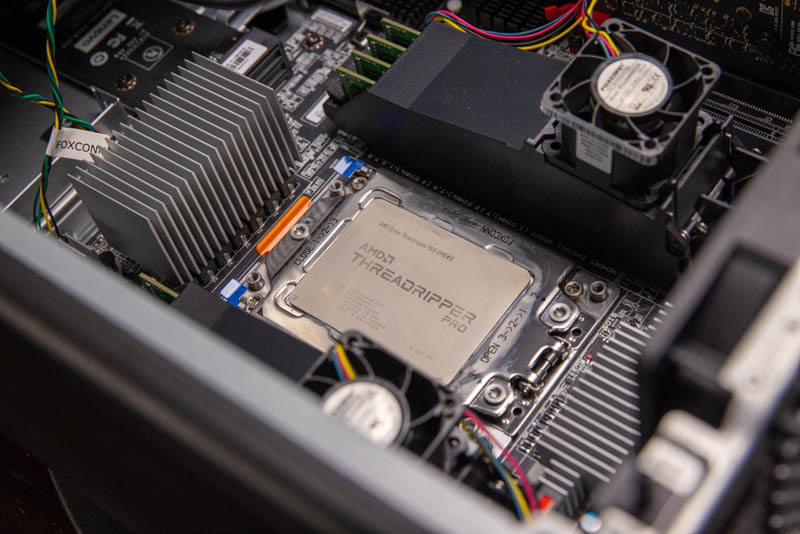
Under the heatsink, we see the AMD Ryzen Threadripper 3995WX. This is a high-end 64-core processor with 256MB of L3 cache, high-clock speeds, and a 280W TDP. This is being launched and sold at a time when Intel’s highest core count Xeons are 28 cores like the Intel Xeon W-3275.
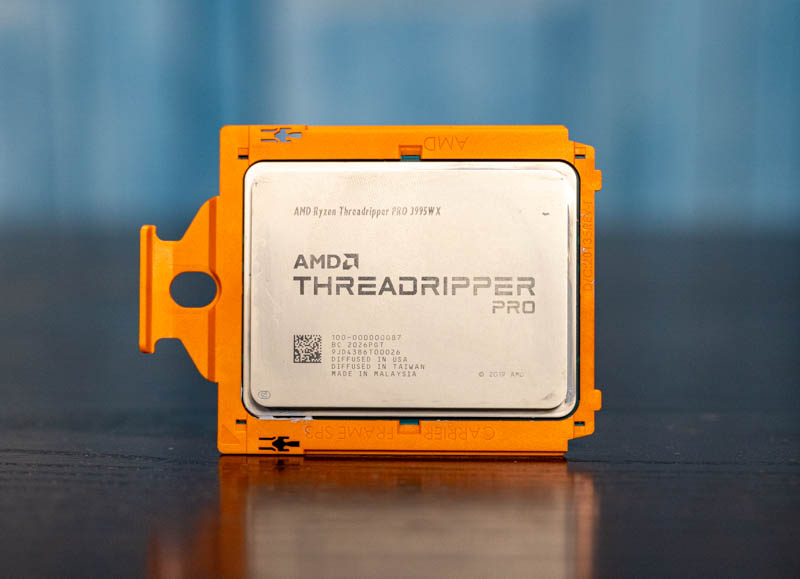
We will just take a moment to look at the heatsink from another angle. This unit has a copper base and heat pipes with two segments of fins and two fans. The heatsink/ fan assembly is so large that you can see on the far side of the heatsink that the heatsink/ fans extend past the SP3 socket. That is why we have holes in the heatsink to allow one to get a screwdriver down to the socket. A small but interesting note is that Lenovo is using a Philips head heatsink while the vast majority on the market are Torx to match the SP3 socket screws.

As part of the AMD Ryzen Threadripper Pro value proposition, we get the same 8-channel memory configuration that we get on the AMD EPYC 7002/ 7003 line. Although we typically do not get a large amount of airflow on the server DIMMs, we get airflow guides and fans on these DDR4-3200 DIMMs.

Another key feature is that we get ECC RDIMM support. Using 64GB RDIMMs which are fairly reasonably priced these days at a lower cost per GB than 128GB units, gives us 512GB of memory across the 8-channels.
Below this area, we have a NVIDIA Quadro RTX 6000 GPU. This is the second highest-end GPU of its generation.
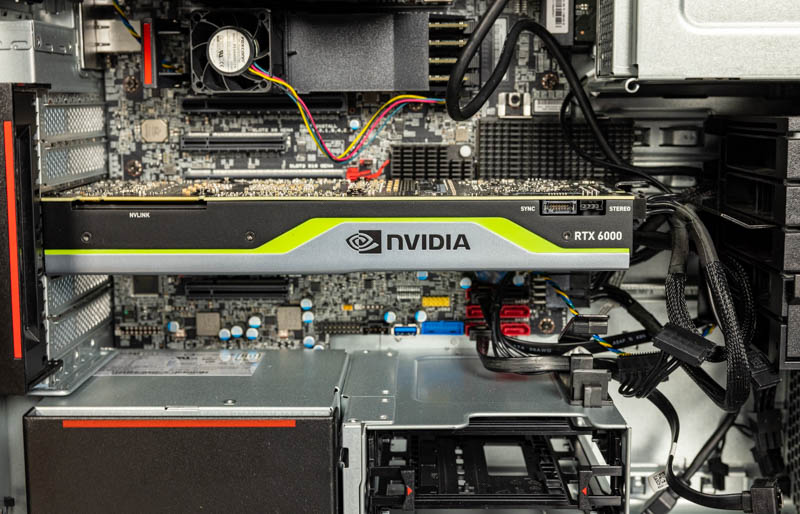
We checked the specs and it seems that Lenovo supports dual GPU configurations, but not triple GPU configurations. Perhaps that will change but for now it seems reasonable. Lenovo is not using as many PCIe lanes here as the platform has, even with the M.2 storage there seems to be more in the Threadripper Pro platform than Lenovo is exposing.
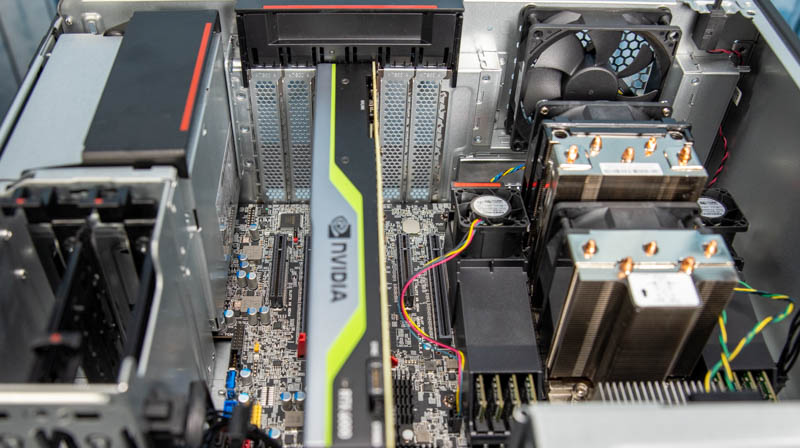
Below the PCIe area, one can see the internal USB Type-A header then a bottom section of the chassis. Here one can see a PSU on the left and storage on the right. The storage is not in hot-swap bays. Instead, there are SATA power and data cables in the chassis. Lenovo has a nice tray design, but at this price range, it would have been nice to have a hot-swap backplane.
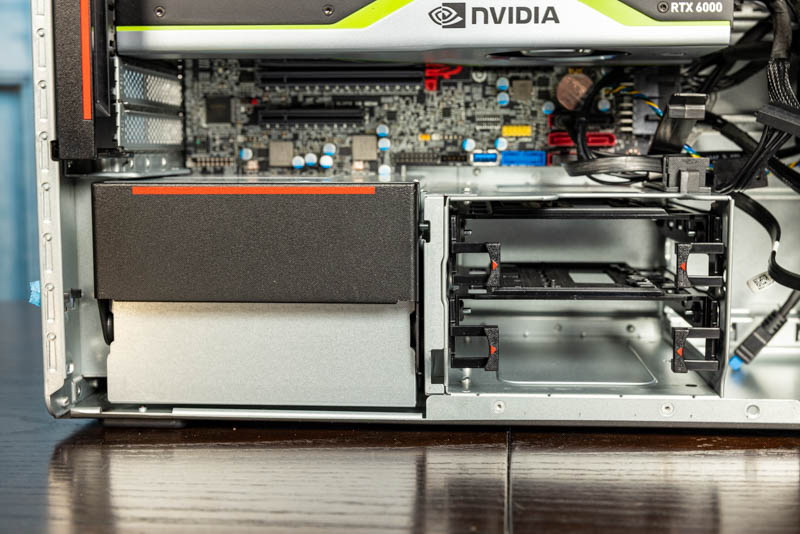
Something you will notice is that there are many items marked in red. Those correspond to points where one can service the chassis. Those include places such as the rear I/O that there is a bar to secure the expansion cards and even the power supply. Here we can see the PSU is being pulled out. This is a really nice design and in many ways is more similar to what we see with servers as the motherboard PCB extends to where the PSU connects. One small bit is that this PSU is a 1kW 80Plus Platinum unit. That may sound like a lot, but the Threadripper 3995WX can use 280W, the GPUs can be over 250W each. That does not leave a lot of margin for other components in a fully configured system.
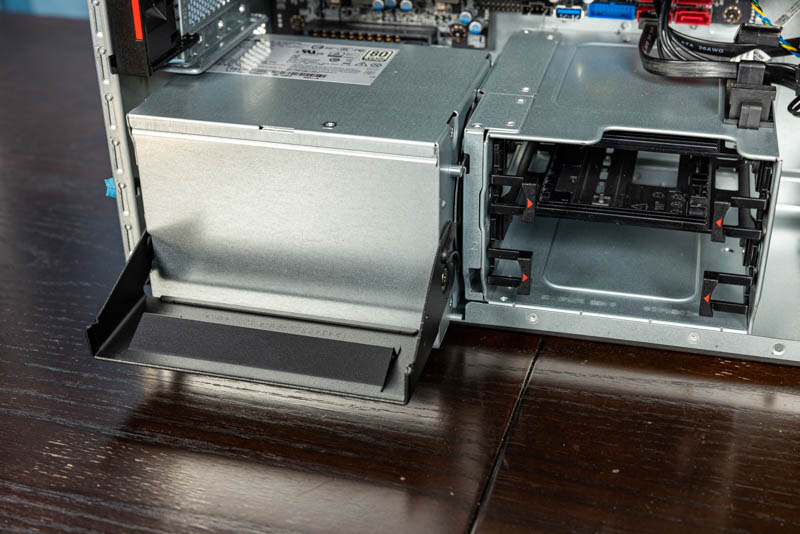
One item that we should note here is that this system uses AMD DASH for management, not something like Lenovo XClarity. That keeps costs down, and while this is technically a desktop workstation, having a higher-end management interface would be a welcome way to increase manageability.
Overall, this is a very nice system. There is certainly some room for adding another level of features such as more networking, a hot-swap internal storage array, a larger PSU, or more PCIe lanes. Still, for a first offering to launch the Threadripper Pro series, this is a solid offering.
Before we get on with our testing, let’s look at Lenovo P620 Threadripper Pro Workstation Software.

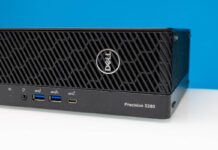

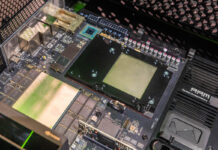
How many dB 1m from chassis when under load and idle?
1. Stop using “WEPYC”, it’s misleading and sounds atrocious
2. The DVD bay does not rotate to make it tower like? Dell/Supermicro have been doing that for ages, shame Lenovo could not have done the same.
3. Stop using “WEPYC”
Another good article, and nothing wring with the WEPYC nickname.
But Wepyc is just such an awesome name for what this is. AMD should pay Patrick to adopt it, in fact.
The pre-discount pricing of U$6K for 16c 32MB was eyewatering, discount pricing is still a bit stiff: https://www.lenovo.com/us/en/think-workstations/thinkstation-p-series-towers/ThinkStation-P620/p/33TS3TPP620 – the “W” is for Whoa!
It just occurred to me that the 12/16C models will suffer from the memory bandwidth problem, no? If they are indeed implemented as two CCD as the Wikipedia page suggests, then the aggregate CCD to/from IO die connectivity would be half of the 8 channel memory bandwidth. That sucks. I would have expected 12/16C models to be implemented with 4 CCD even if that means only singe CCX is used on a CCD. Bummer!
I have a P620 with the 3945WX and a W5700 on the way. I only have enough RDIMMs to do a four channel test, but I’m willing to run any benchmarks anyone here would like.
If anyone has four more 16GB RDIMMs to toss my way for benchmark purposes I could check the bandwidth question out as well.
hi Rob,
it’s 15 years since I last wrote a PO myself and to the old public Dell, however we enjoyed better than any online quotes and specials and far better than that on GPUs.
we were able to buy as a small business customer after engineering to be a non consolidated subsidiary of our parent.
many corporate organisations incorporate functions and divisions separately but breaking them out if they’re going to be consolidated anyway is not always easy to negotiate. We did and certainly could, because of a excellent structured finance department who kept us a startup in every positive and naturally inherently eminent way we were.
I mention this because if you need a high degree of acceleration and options, unless the parts aren’t available via the small business channel (PERCs were not on workstations at least at that time*) the possibility of developing a positive relationship with your account manager who may benefit from developing their familiarity with your niche market needs, feeds from this naturally and did with us on numerous occasions.
*I really should add my caveat emtor to bending sales channels that I learned when the Adaptek card lost its array tables in a way that no LSI would have done. I was asking to serve my head on a plate to the data gods when I said “go ahead” despite a consensus suspicion that that “PERC” (labelled, silk screened and BIOS declared) was inevitably going to lose the array tables, because not only didn’t anyone we could find believe that the PERC brand would be risked and the manual pages were identical to earlier parts and yet despite being never in doubt about our relationship with Dell our Dell counterparts themselves were as dumbfounded as the extent of cliché and caricatures can exemplify. I think we’ve still this very machine in storage – we mothballed it immediately afterwards in case anyone else needed to corroborate a identical failure and needed a case study to invoke insurance terms or even if Dell needed to go back to the OEM. I have never ever heard of a Adaptek in a Dell otherwise and this was in my view the time when Dell was beginning to scream out for the help that privatisation eventually delivered resoundingly.
if you are independent or able to get independent tax codes for your subsidiary unit and are looking at large – for – normal – small – business purchasing, and you have the time and manpower and the further time after purchasing, to level up your vendor team to understand your needs, and this is fine with vendor corporate, I have to say that we enjoyed superb experiences and economic terms as close to the bone as we could dare to ask. I highly recommend this strategy for a initial training project, for example.
I still omitted my points :
merely being more familiar with the technology would have almost certainly prevented that data loss – the card was fully supported but I am Perfectly Peachy Embarrassed just writing about this 15 years later because obviously I called it stupidly. Nonetheless, if our support technician and his line management worked datacenter accounts and not small business, I think numerous safeguard actions would have at least intervened to stop my stupidity. In my defense the data loss was meta data loss only, but expensive because it was the only copy of my nearly finished hand indexing of my 20 years of research files and papers and correspondence. I hadn’t backed up the most recent key to the tape archive job. Actually this whole mess was caused by my impatience with finishing work that wasn’t necessary at all and I was lucky to lose no records.
yep I am still beating myself up over that
the positive reason for this writing however I hope makes those previous pixels more acceptable, because I could have lead with more recent successes with obtaining dramatic discounts on integrated vendor hardware and maybe I should have done so.
in 2005 our Quadros MSRP $5,000 turned into line items at numbers below $2,000
we’ve been out of GPU requirements for 3 generations
however what I just said has been a reliable ballpark for the whole of this century for my company through multiple different types of incorporation and geographical location.
bluntly if you can get better discounts on GPU for today’s silicon, and I included as much caveats as I could since I can’t say anything except for the obvious which is you’d be doing extremely well to obtain comparable discounts as we have in the past, however despite my uncertainty in many respects, I am entirely sure that significant margin exists to reduce your quotes for workstations like this WEPYC today.
if you can invest in your vendor channel relationship sufficiently to the level where you can believe that your reps and team are going to build their business and break targets thanks to your involvement with them, I am entirely sure that you can secure the most meaningful economic benefits for your business that are possible for your vendor to afford you.
before you think about pricing however, do you have the capacity to reverse engineer your vendor’s team’s economics sufficiently accurately so that you will not be hitting any of their pain points during your negotiations?
are you sure that you can use independent economic intelligence to your advantage in ways that are absolutely incapable of creating in your vendors team any suspicion of leaking to you in any way whatsoever?
(buying industry market intelligence is a good option here and may potentially be helpful for your vendor team to learn from, although I don’t need to advise against didactic demeaning it’s really worth working out how this comes across beforehand and I’ve cold called at board and CxO for 35 years and I don’t find this at all easy)
I’ve blackened too many pixels here but I’ll leave this with just saying that the price of a specialist PR to write and photograph / talking head shoot the sale as a case study could repay you many times over. my company used to do all that as well if I asked I’ll respond best I can / appropriate / offline
” WEPYC ”
should have been coined in conversation with some interesting participants in the workstation EPYC ecosystem, to give it the introduction necessary.
This is a seemingly trifling but very definitely serious loss to the pandemic. Any other year and the PLATRONYM WEPYC would be serving efficient duty in the war on the market selling advanced solutions depending on the EPYC ecosystem. Chatting with the vendors most impacted – anyone needing PCIEV4 will do, but someone who has a good enough horizontal angle to want to downplay the platform and present their solutions as turnkey would be behind using WEPYC in enough ways it would have take-up plenty as of Christmas in private already.
I reacted negatively at first but quickly realised that my reaction was caused by the lack of vital context and transforming meaning.
the reaction I’m reading signals to me only that we’re hurting in unseen ways without closer industry community contacts happening
oh, I consistently was securing the First In Country Supply for the parts that we wanted.
this and our developed strategy has delivered us components frequently before very major accounts got theirs
supply has clearly stratified beyond recognition of my personally responsible days, we have delayed buying metal ourselves for over 2 years and will probably take delivery 3 years after our original planning dates, because we wanted to learn intimately what’s going on around the industry now. We’ve used cloud machines to be as early as possible as general public to learn as much as possible without any favors. Because of the stratification and the pressure of demand for next generation hardware, we’ve tried to pass on the present cycle to use this cycle to develop the knowledge and relationships – extending outward from who we work with already wherever possible – the risks we considered necessary to avoid to the point that we’re effectively contracted to key customers instead of selling to the market for now.
apart from boasting about the results I’ve helped get negotiating with vendors, I’m wanting to say that if you are likewise talking with new people and new channels, from where I see lots of people are almost sitting this one out to commit better in H222. no need to even necessarily start hinting about bigger business to come next time because I think about everybody is doing similar
hi to William and Patrick and STH team!
any chance of getting two MSI 3090s into this wepyc to test with the rest of the slots as loaded as possible?
I’ve written altogether too much but my business encompasses video production and 8K RED raw files scrub nicely only with RTX silicon which Apple doesn’t sell leaving clackintoshes (cloud + hack +) run on esxi the most sensible interim way
many people would love to serve a RTX to a colleague while checking out the state of play on Linux and Windows, Linux extensively used for paint and color work witht the high end applications coming within reach of the many due to hardware improvements so vastly lower license pricing recently (tens of kilobucks per seat to low single digit thousands now for Katana and Mark and similar to zero for NLEs…) and with bundles of legacy cards to bring over, this is a highly relevant configuration to think about. Consider everybody who could afford got a $20k RED rocket FPGA raw decode accelerator card only 3 years ago… the Brits are big in this game too and getting much less support for everything. Meanwhile the indy industry is in trouble big time and can’t afford to pay twice for workstations. this is a market in desperate need of your attention and insights.
Anyone knows the “normal” weight of this workstation? Lenovo’s documentation only lists maximal weight, which might include multiple GPUs and HDDs. I’d like to get one, however I need to put it in a holder hanging from a desk, which has strict weight limits. The maximal weight listed on Lenovo’s site is way above that maximum.
Got an answer on Lenovo forums: 29lbs / 13.2kg for a basic version. Going to get one soon.
Great machine but our newly purchased ThinkStation P620 suffers from a sudden power loss type shutdown, usually when not under any load. This happens around every 2 weeks.